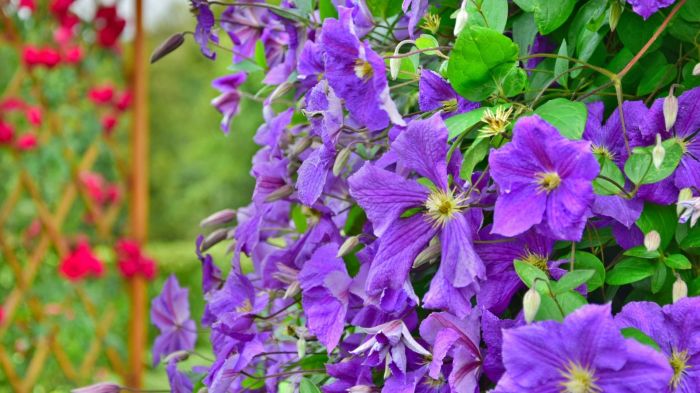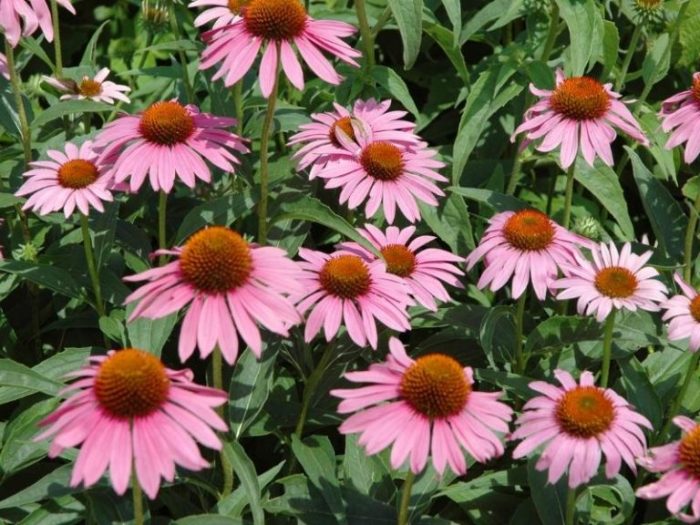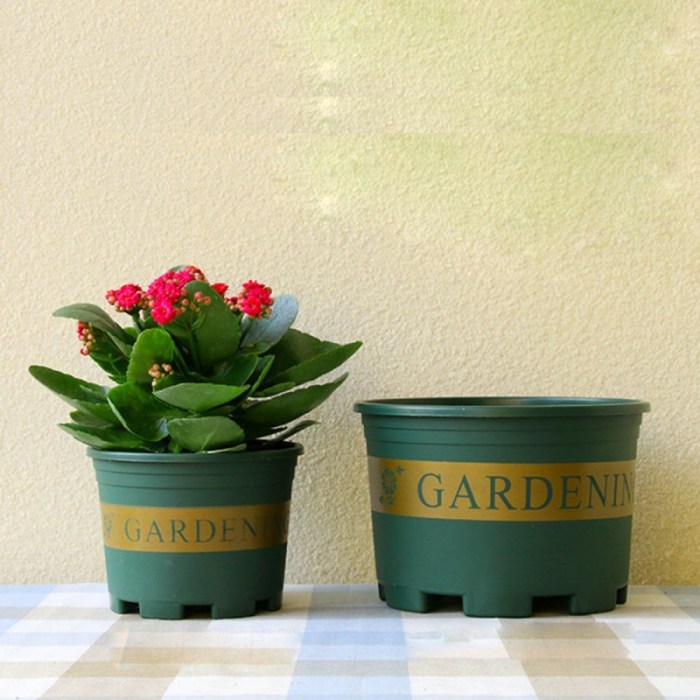Identifying Vining Plants with Purple Flowers: Vining Plant With Purple Flowers

Vining plant with purple flowers – Yo, peeps! So you’re digging vining plants with purple flowers, huh? That’s a pretty rad aesthetic. Let’s get into the deets on some seriously awesome climbing plants that’ll totally level up your garden game or even your indoor space. We’re talking vibrant purples, unique leaf shapes, and all the grow tips you need to keep these beauties thriving.
Vining Plants with Purple Flowers: A Detailed Overview, Vining plant with purple flowers
Here’s the lowdown on ten killer vining plants that boast purple flowers. We’re breaking it down by plant name, flower color variations (because sometimes purple comes in different shades, you know?), bloom time (so you know when to expect the show), and growing requirements (because nobody wants a wilted vine).
| Plant Name | Flower Color Variations | Bloom Time | Growing Requirements |
|---|---|---|---|
| Morning Glory (Ipomoea purpurea) | Various shades of purple, sometimes with white or pink | Summer | Full sun, well-drained soil, regular watering |
| Purple Clematis (Clematis viticella) | Deep purple, sometimes with lighter shades | Summer | Full sun to partial shade, well-drained soil, consistent moisture |
| Purple Passionflower (Passiflora incarnata) | Deep purple and white, intricate flower structure | Summer | Full sun to partial shade, well-drained soil, moderate watering |
| Hyacinth Bean (Lablab purpureus) | Purple, sometimes white or pink | Summer and fall | Full sun, well-drained soil, regular watering |
| Purple Potato Vine (Solanum rantonnetii) | Bright purple, star-shaped flowers | Spring to fall | Full sun, well-drained soil, moderate watering, drought-tolerant |
| Cup and Saucer Vine (Cobea scandens) | Bell-shaped, deep purple flowers | Summer and fall | Full sun to partial shade, well-drained soil, regular watering |
| Black-Eyed Susan Vine (Thunbergia alata) | Various shades of purple, often with a dark center | Summer and fall | Full sun to partial shade, well-drained soil, moderate watering |
| Purple Wisteria (Wisteria sinensis ‘Prolific’) | Deep purple, pendulous flower clusters | Spring | Full sun, well-drained soil, regular watering, needs support structure |
| Cardinal Climber (Ipomoea x multifida) | Deep red-purple, star-shaped flowers | Summer | Full sun, well-drained soil, regular watering |
| Sweet Potato Vine (Ipomoea batatas) | Purple foliage, small purple flowers (less prominent than foliage) | Summer | Full sun to partial shade, well-drained soil, moderate watering, drought-tolerant |
Distinguishing Characteristics and Ideal Growing Conditions
Each of these vines has its own unique vibe. For example, Morning Glories are known for their heart-shaped leaves and rapid growth, while Clematis boasts more intricate, feathery leaves and can climb to impressive heights. Purple Passionflower is all about its unique, almost alien-looking flower structure. Paying attention to leaf shape, growth habit (how they climb—some twine, others need support), and mature size helps you pick the perfect vine for your space.The ideal growing conditions also vary.
Some, like Morning Glories, thrive in full sun and need regular watering, while others, like Purple Potato Vines, are more drought-tolerant. Always check the specific needs of the plant you choose to ensure it flourishes. Getting the soil right—well-drained is usually key—is also crucial. Think of it like this: You wouldn’t want your kicks soaked, right?
Same goes for your vines’ roots.
Vining plants with purple flowers, like clematis or morning glories, add vibrant color to any garden. Before planting, however, ensure you’ve prepared the soil correctly; you’ll want to consider whether can you plant flowers in mulch , as this can greatly impact their growth. Proper soil preparation, including mulching, is key to thriving purple blooms on your vining plants.
Uses and Applications of Purple Vining Plants
Yo, Surabaya peeps! So you’ve identified your purple vining plants, right? Now let’s talk about what you canactually do* with these bad boys. From sprucing up your pad to helping out Mother Nature, these plants are way more versatile than you think. We’re talking serious landscaping game, floral artistry, and even a boost for the local ecosystem. Get ready to level up your green thumb!These vibrant purple vines aren’t just pretty faces; they’re incredibly useful in various settings.
Their adaptability and aesthetic appeal make them a popular choice for enhancing both indoor and outdoor spaces, while also playing a vital role in supporting local biodiversity.
Landscaping Applications
Purple vining plants are total game-changers in landscaping. Their climbing habit makes them perfect for creating stunning vertical gardens, adding depth and color to walls, fences, and even building facades. Imagine a wall completely covered in cascading purple blooms –major* aesthetic upgrade for any urban space. They can also be used as ground covers, creating a vibrant carpet of purple that smothers weeds and adds a touch of elegance to pathways or empty spaces.
For a more structured look, train them up trellises or pergolas, creating beautiful shaded areas or eye-catching architectural features. Think of a romantic pergola draped in vibrant purple morning glories – perfect for that Instagram-worthy photo shoot.
Floral Arrangements and Decorative Purposes
Beyond landscaping, these purple vines are seriously stylish in floral arrangements. Their unique shapes and colors add a touch of wildness and sophistication. Imagine incorporating them into bouquets, centerpieces, or even wreaths. The long, trailing vines can be beautifully arranged to create flowing, dramatic effects. You can even dry them to create stunning purple accents in winter arrangements.
Think of it: dried purple vines adding a pop of color to your minimalist aesthetic.
Ecological Importance
These aren’t just pretty plants; they’re vital for the environment. Many purple vining plants are excellent at attracting pollinators like bees and butterflies, which are essential for plant reproduction and maintaining a healthy ecosystem. The dense foliage also provides shelter and nesting sites for various insects and small animals, increasing biodiversity in your area. This means a healthier, more vibrant garden, contributing to a thriving local ecosystem.
Planting these vines is like giving back to nature – a serious win-win.
Potential Challenges and Solutions

Yo, Surabaya peeps! Growing those killer purple vining plants ain’t always a walk in the park. Sometimes, things get a little…complicated*. Let’s break down some common issues and how to totally slay them.
Common Diseases and Pests
Maintaining the health of your purple vining plants requires vigilance against various diseases and pests. Ignoring these issues can lead to significant damage or even plant death. Early detection and prompt treatment are crucial for successful plant management. Here’s a breakdown of common problems and their solutions:
| Problem | Solution |
|---|---|
| Powdery mildew (a white, powdery coating on leaves) | Improve air circulation, avoid overhead watering, and use a fungicide like neem oil or potassium bicarbonate. Regularly remove affected leaves. |
| Aphids (small, soft-bodied insects that suck plant sap) | Blast them with a strong spray of water, introduce ladybugs (natural predators), or use insecticidal soap. |
| Spider mites (tiny mites that create webs on leaves) | Increase humidity around the plants, use insecticidal soap, or introduce predatory mites. |
| Root rot (caused by overwatering and poor drainage) | Ensure well-draining soil, avoid overwatering, and improve air circulation around the roots. Consider repotting in fresh soil if necessary. |
| Downy mildew (fuzzy grey or purple mold on leaves) | Remove and destroy infected leaves, improve air circulation, and apply a copper-based fungicide. |
Climate-Related Challenges
Surabaya’s weather can be pretty unpredictable, right? These purple vine plants have their preferences. Understanding and adapting to these preferences is key to success.Growing these plants in different climates presents unique challenges. For example, in hotter, drier climates, regular watering and possibly shade during the hottest parts of the day may be necessary. Conversely, in cooler, wetter climates, providing adequate drainage and protection from frost or excessive rain is crucial.
Adapting watering schedules and providing support structures are crucial for optimal growth.
Toxicity
Some purple vining plants, like certain species ofIpomoea*, can be toxic if ingested. Keep them away from pets and small children. Always wear gloves when handling them, especially if you have sensitive skin. Thorough handwashing after handling is essential. If ingestion occurs, contact a poison control center immediately.
Quick FAQs
What is the best time of year to plant purple flowering vines?
The best time to plant depends on your specific climate and the vine species. Generally, spring or fall, after the last frost, is ideal for most vines, allowing them to establish roots before extreme temperatures.
How much sunlight do purple flowering vines need?
Most purple flowering vines thrive in full sun to partial shade. Check the specific requirements of your chosen species, as some may prefer more shade than others.
Are purple flowering vines invasive?
Some species are more vigorous growers than others. Research the specific vine you choose to ensure it’s suitable for your space and won’t become invasive. Regular pruning can help manage growth.
How can I encourage more purple flowers?
Provide adequate sunlight, well-draining soil, and regular fertilization. Deadheading (removing spent flowers) can also encourage more blooms.



